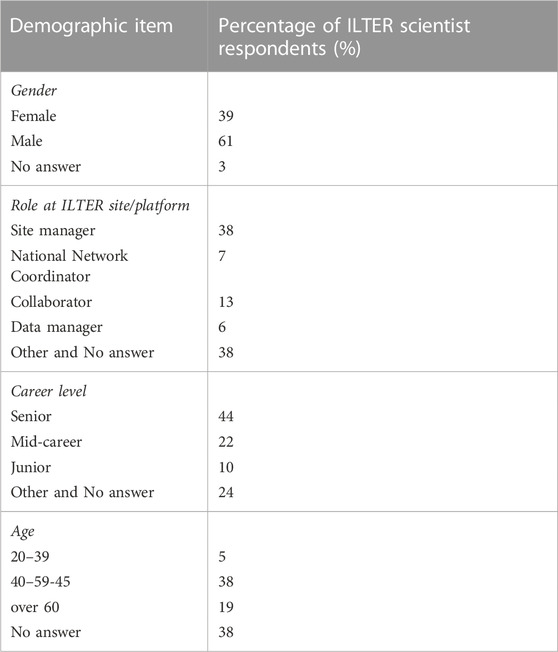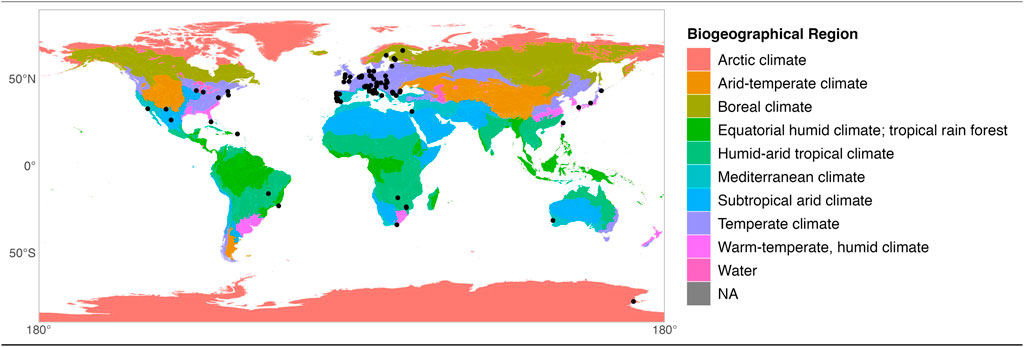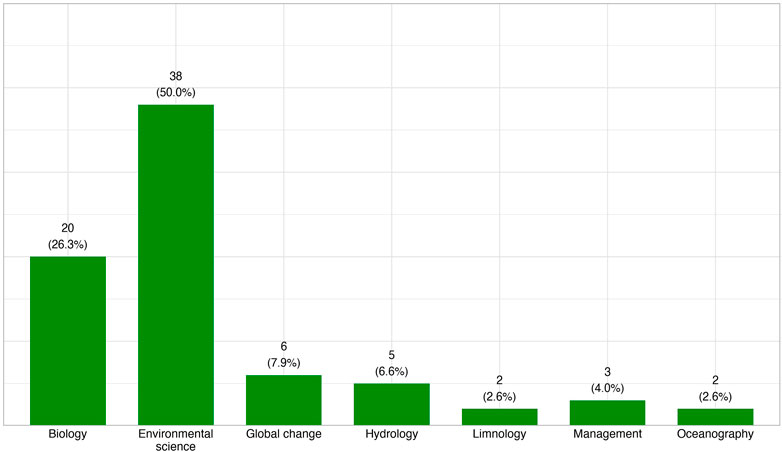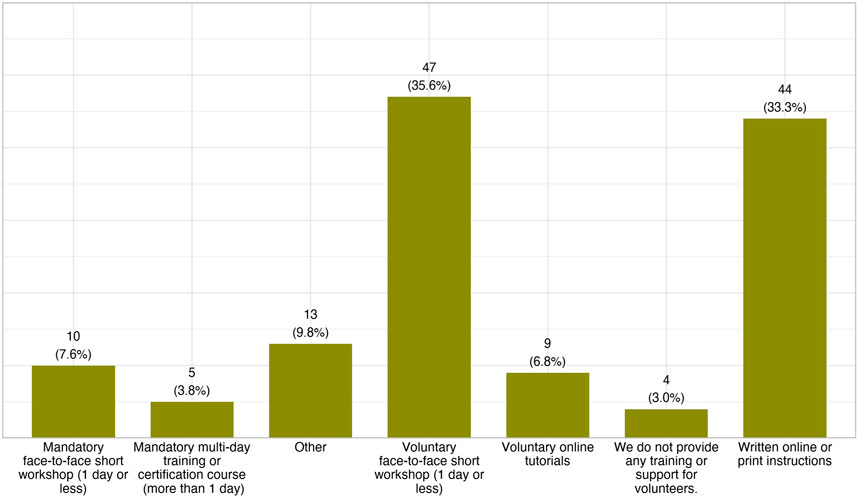- 1Institute of Marine Sciences, National Research Council, ISMAR-CNR, Milan, Italy
- 2Research Centre for Plant Protection and Certification, Council for Agricultural Research and Economics, CREA-DC, Rome, Italy
- 3Center for Environmental Science, University of Maryland Center for Environmental Science, Cambridge, MD, United States
- 4Institute for Electromagnetic Sensing of the Environment, National Research Council, IREA-CNR, Milan, Italy
In the last decades, citizen science (CS) has experienced an increasing interest as a practice in which scientists and citizens collaborate to produce new knowledge for science, society and policy. Environmental and ecological sciences are among the most active in proposing CS activities and new models for citizen participation in research. In addition to environmental dimensions, these fields necessarily include social and cultural dimensions to confront the complex local and global environmental challenges. This is particularly evident in the International Long-Term Ecological Research (ILTER) network, where the integration of social sciences has become a recognized priority. ILTER offers a valuable landscape to explore common CS features across a wide range of different cultural and socio-ecological contexts, as well as worldviews of science-society interactions. In 2020, we surveyed scientists working at ILTER sites across the globe to identify key features of CS initiatives in which they are/were involved and the levels of participation of the volunteers. We consider these features in the context of the internationally-developed “Ten Principles of Citizen Science” by examining scientific outcomes and societal/policy impact, type of volunteers’ involvement, and sharing of data/findings and feedbacks and acknowledging volunteers. Our results indicate that the ILTER community demonstrated a good predisposition toward environmentally-focused CS initiatives with diverse scientific questions including biodiversity, water quality, ecosystem services and climate change. Most of the respondents reported that the volunteers were involved mainly in collecting samples or recording data; some other activities, such as dissemination of the project conclusions and discussion and translation of the results into action, were also mentioned. Volunteers were usually trained for these initiatives and acknowledged in peer-reviewed publication, however data from the initiatives were only partially shared openly. We conclude with remarks and suggestions for expanding design and implementation of CS in the ILTER community.
1 Introduction
Citizen science (CS) refers to the active engagement of the general public in scientific research and is experiencing an increasing interest in the last decades as a practice in which scientists and citizens collaborate to produce new knowledge for science, society and policy (Silvertown, 2009; Theobald et al., 2015; Kullenberg and Kasperowski, 2016; Haklay et al., 2021). Data collection is the most popular form of citizens’ engagement (Theobald et al., 2015; Kullenberg and Kasperowski, 2016; Turrini et al., 2018; Stylinski et al., 2020), although volunteers can contribute in other ways such as co-design and co-creation, through problem definition, data analysis, and interpretation and dissemination of results (Shirk et al., 2012; Haklay, 2013; Chapman and Hodges, 2017; Haklay, 2017).
Several authors have thoroughly discussed the many benefits of CS for scientific research, environmental monitoring, and the decision-making process; these include knowledge and skills gains for both volunteers and scientists as an avenue to promote two-way collaboration and engagement for both citizens and scientists (e.g., Lidskog, 2008; Hochachka et al., 2011; Aceves-Bueno et al., 2015; Branchini et al., 2015; Bonney et al., 2016; Ballard et al., 2017; Turbé et al., 2019). Moreover, CS is considered as an emerging example of a non-traditional data source that can contribute to the United Nations Sustainable Development Goals (SDGs; Fritz et al., 2019; Fraisl et al., 2020) and global biodiversity targets (Chandler et al., 2017). Many CS programs are well suit for this contribution because they cover a wide range of global biodiversity research (e.g., Greenwood, 2007; Theobald et al., 2015; Geijzendorffer et al., 2016; Chandler et al., 2017; Fraisl et al., 2022) and collect information on population dynamics, health and distribution of terrestrial and marine organisms (e.g., Miller-Rushing et al., 2012; Zapponi et al., 2017). CS may also provide valuable support to institutional long-term environmental monitoring programs by the Environmental Protection Agencies and Protected Areas in Europe and the United States (e.g., Owen and Parker, 2018; Rubio-Iglesias et al., 2020; Garcia-Soto et al., 2021; Halliwell et al., 2021; Vohland et al., 2021).
In the last decades, progress in CS has been also organizational, since several CS networks have been established and grown, such as the US Citizen Science Association (CSA), the Australian Citizen Science Association (ACSA) and the European Citizen Science Association (ECSA), providing forums for the exchange of knowledge and ideas, as well as identification of shared goals and best practices. In 2017, the Citizen Science Global Partnership (CSGP)1 was launched as a network-of-networks seeking to promote and advance CS for a sustainable world and bringing together existing networks of CS researchers and practitioners with advisory boards representing policy, business, and community-based perspectives. Within this wide international community of CS practitioners and researchers, the “Ten Principles of Citizen Science” have been developed. They are a framework to assess new and existing CS initiatives with the aim of fostering excellence in all aspects and providing a common set of tenets for governments, decision-makers, researchers and project leaders, to consider when funding, developing or evaluating CS projects (ECSA, 2015; Eitzel et al., 2017; Robinson et al., 2018).
Environmental and ecological sciences are among the most active pursuing CS activities and new models for citizen participation in research (Vohland et al., 2021). In addition to environmental dimensions, these fields necessarily include social and cultural dimensions (Haberl et al., 2006; Groffman et al., 2010; EEA, 2021a; EEA, 2021b), in order to confront complex local and global environmental challenges. This is particularly evident in the International Long-Term Ecological Research (ILTER) network2, where the integration of social sciences has become a recognized priority (Singh et al., 2013; Dick et al., 2018; Mirtl et al., 2018). ILTER comprises 44 active member-networks representing 700 LTER sites and 80 LTSER (Long-Term Socio-Ecological Research) platforms across all continents (Wohner et al., 2021). The overall purpose of ILTER is to provide a globally distributed network and infrastructure of long-term research sites for multiple uses in the fields of ecosystem, biodiversity, critical zone, and socio-ecological research (Mirtl et al., 2018). The high spatial and temporal resolution of ecosystem research and monitoring carried out by the LTER sites enables the detection of both slow and extreme changes in ecosystem functioning, responding to a number of drivers and pressures (Mirtl et al., 2018). ILTER is also an example of a multiple and inter-disciplinary community, engaging more than 200 institutions, several thousand scientists, and diverse disciplines. Socio-ecological research in LTER networks aims at addressing global and regional sustainability challenges involving a broad stakeholder community in the measurements and the co-design of investigation practices and in the definition of research priorities (Haberl et al., 2006; Mauz et al., 2012; Dick et al., 2018). This implies a strong commitment of scientists to work within an interdisciplinary context (involving natural, social and human scientists), and willing to engage with communities/stakeholders.
For all these reasons, ILTER offers a valuable opportunity to explore common CS characteristics across a wide range of different cultural and socio-ecological contexts, as well as worldviews of science-society interactions. With this purpose, in 2020 we surveyed scientists working at ILTER sites and LTSER platforms across the globe, to examine features of the ILTER CS initiatives, level of involvement of the volunteers, and the attitudes of ILTER scientists about CS. ILTER scientists’ attitudes are reported in a companion paper (L’Astorina et al., 2023); here we focus on the features of ILTER CS initiatives: geographical and biogeographical distribution; spatial and temporal scale; research foci; type of volunteer involvement and of data collected, and data validation efforts. We consider these features in the context of the “Ten Principles of Citizen Science” by examining scientific outcomes and societal/policy impacts, type of volunteers’ involvement, sharing of data/findings, the feedbacks and acknowledging volunteer involvement. We conclude with suggestions for expanding design and implementation of CS in the ILTER community.
2 Materials and methods
2.1 Questionnaire development
We collected information through an online questionnaire, available as Supplementary Material, aimed at the ILTER network. To draft and validate it, we held a workshop at the 2019 ILTER Open Science Meeting and asked the 14 attending science professionals to create a preliminary list of reasons why scientists would participate in CS, as well as a list of associated challenges. Building from this and related literature and inventories (e.g., Riesch et al., 2013; Golumbic et al., 2017; Tredick et al., 2017; Besley et al., 2018; Robertson Evia et al., 2018; Stylinski et al., 2018), the first version of the questions was developed and then pilot-tested by a group of 14 environmental scientists who were not involved within ILTER (10 were non-native English speakers). Based on the feedback from the pilot scientists, the questionnaire was revised and implemented on Qualtrics3, an established online questionnaire tool. The different phases of the survey development are shown in Figure 1.
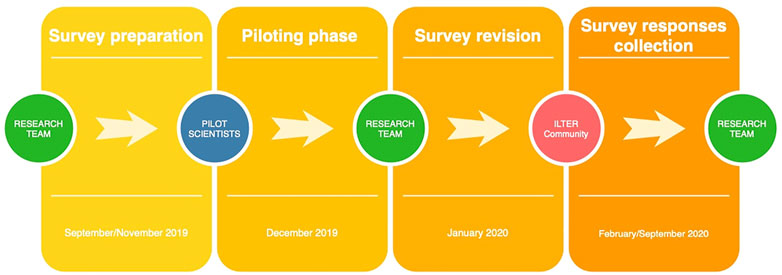
FIGURE 1. Phases and timing of the development of the questionnaire with the involved actors in each phase.
The final online questionnaire consisted of 35 single-answer/multiple-choice, multiple-answer/multiple-choice or open-ended questions, subdivided as follow.
1) Attitudes of scientists towards CS and other public engagement (4 questions on communication objectives, reasons, willingness and barriers)
2) Citizen scientists’ involvement (1 question using a 5-point Likert scale)
3) Impact on scientists (1 question)
4) Inventory on a selected CS Initiative (22 questions)
5) Demographics (5 questions on role at the ILTER sites and platforms, career level, age, gender and scientific field of interest)
6) Geographic context (2 questions on country where they work and on the DEIMS. iD4 of the ILTER site/platform they manage).
In this paper, we focus on the analysis of the inventory and demographic items and on the level of involvement of Citizen Scientists, while the others are described and analyzed in L’Astorina et al., 2023. To provide an in-depth viewpoint, the questionnaire respondents were asked to focus only on one specific CS initiative (current or past) in which they have been most active and to answer a number of questions to describe it. Questions addressed the following features.
i) Spatial and temporal scale of the CS initiatives
ii) Research focus and research question
iii) Type of volunteers and their level of involvement
iv) Training methodology
v) Data type and quality check
vi) Ways to share data and finding and to acknowledge the volunteers
The questionnaire was accompanied by an informative email specifying the purpose of the study and the use that was to be made with the data that the respondents provided. Respondents were free to choose whether or not to answer any questions. The average survey duration was approximately 20 min.
2.2 Questionnaire administration and response rate
A recruitment email with a link to the questionnaire was sent to all the ILTER site managers through the ILTER secretariat contact list, which encompasses 850 email recipients. The email stated the purpose of the study and asked recipients to complete the questionnaire and share the link with other scientists at their ILTER site/platform. The questionnaire remained open from the end of February to mid-September 2020, with two reminders sent within this period.
In total, we received 163 responses with completeness higher than or equal to the 75% (i.e., all of these respondents completed at least the 75% of the questionnaire). We assumed that site managers either filled out the questionnaire or passed it on to a scientist at their site. Thus, our pool of possible respondents was 850, and our response rate is 17%. This response rate appears consistent with those reported for other online questionnaires of expert communities (e.g., Scott et al., 2011; Dudo and Besley, 2016).
2.3 Data analysis
We used bar plots to visualize the percentage of responses for each feature of the selected CS initiatives and a matrix plot for the level of involvement of the citizens in the different activities. In the bar plots, each bar represents the percentages and the number of respondents that selected multiple choice option. We conducted mean comparisons (paired two-samples Wilcoxon test) to test for significant differences between the various demographic groups. Geographical distribution of CS activities was represented per bio-geographical region (see Olson et al., 2001 for the full list of regions). We also looked for common themes in the open-response questions. The statistical software R (version 4.1.2) was used for all the analyses (R Core Team, 2021). The performed analyses by using the R software are available as open code on GitHub (Oggioni and Bergami, 2022), while the questionnaire results are accessible on Zenodo (Bergami et al., 2022).
2.4 Features of the CS and relation with the ten principles of CS
We compared the six main features of the ILTER CS initiatives with the “Ten Principles of Citizen Science,” which cover a broad range of characteristics of CS, from scientific outcomes and benefits for the citizens to data sharing and ethical issue. To simplify this comparison, we grouped the Ten Principles into three key issues, covering several principles and connected to the six features: i) Scientific outcomes and societal/policy impact, ii) Types of volunteers’ involvement, iii) Sharing of data and findings, feedbacks and acknowledgements (Table 1; Figure 2).
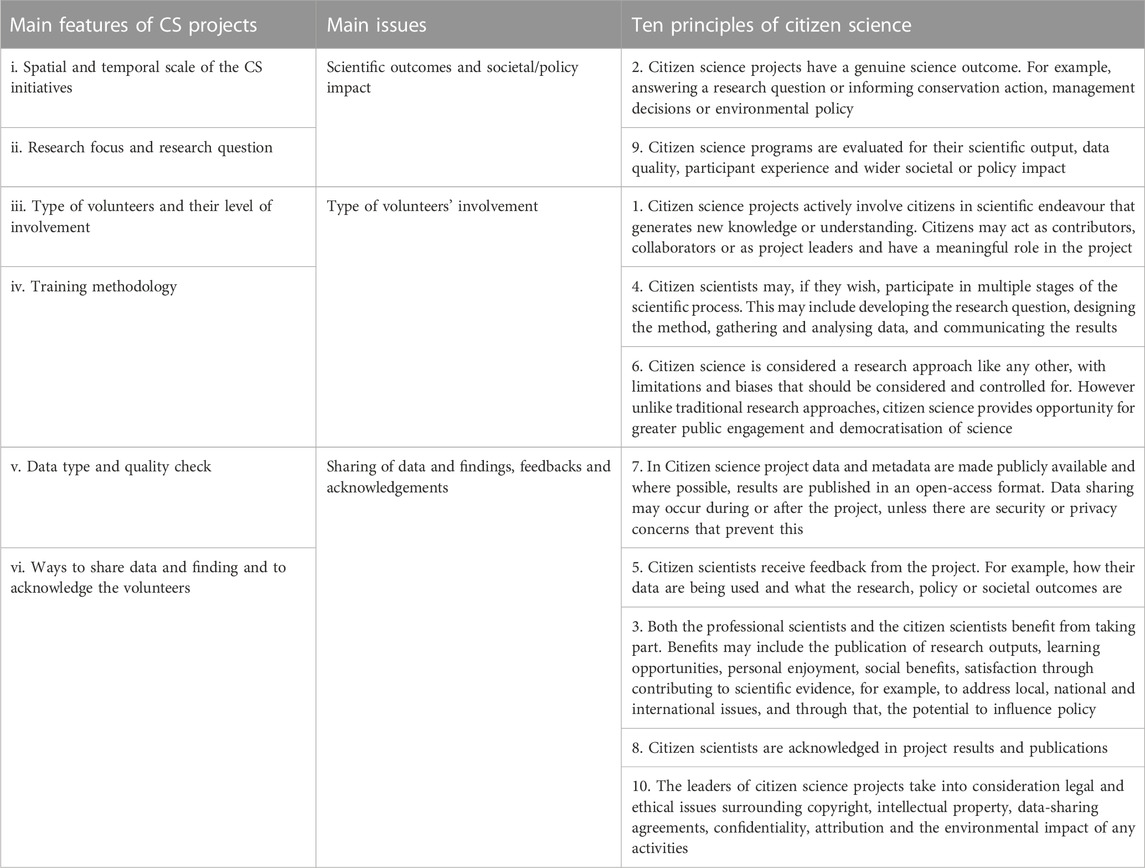
TABLE 1. Main features of the CS initiatives addressed in this study, clustered in three main issues and compared with the 10 ECSA principles (ECSA, 2015; Robinson et al., 2018).
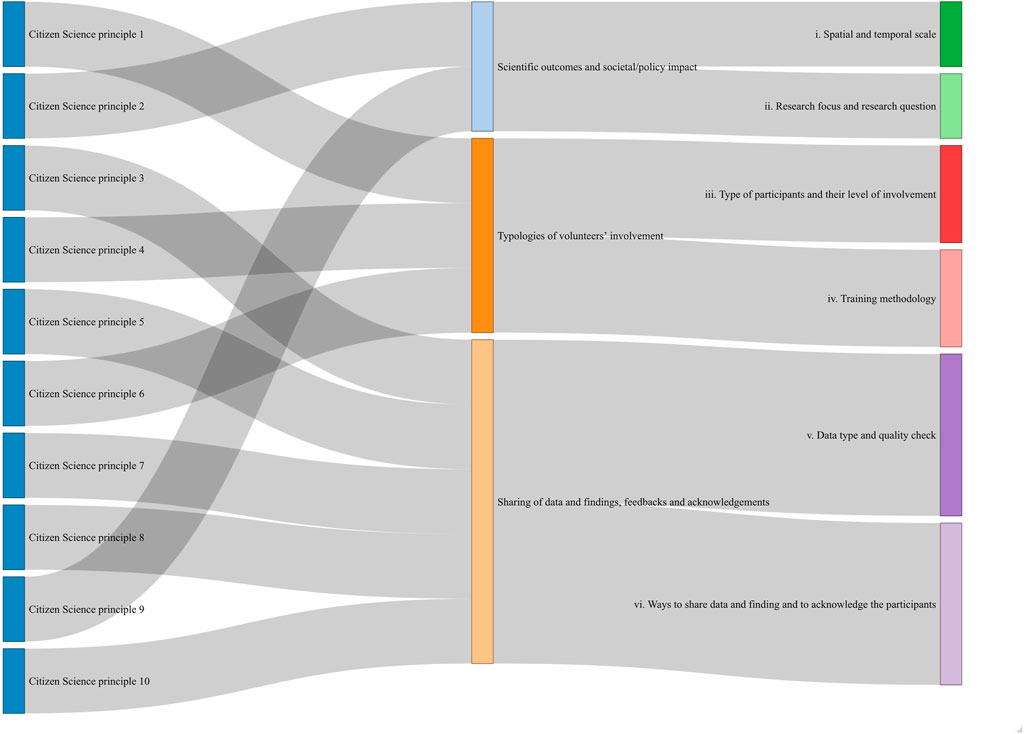
FIGURE 2. Sankey diagram representing the six main features of the selected CS initiatives, their clustering into three main issues and the connections with the Ten Citizen Science principles.
3 Results
3.1 Respondents’ demographics and geographical distribution of the ILTER initiatives
The most common demographic selections were male (61%), ILTER site managers (38%) and senior scientists (44%) and aged between 50 and 59 years (25%) (Table 2). Forty-seven percent of the respondents declared that they have been involved in at least one CS initiative during their scientific career. The total number of current and past CS initiatives carried out at the LTER site or LTSER platform by all the respondents was 392 with an average of 4.6 per respondent. Seventy-six were the selected CS initiatives of which the respondents described the main features.
Eighty-three percent of the respondents gave information about geographic context, which was useful for defining the provenance ILTER network. They primarily worked at LTER sites/platforms in Europe (58%) with additional respondents working in the US (10%), East-Asia-Pacific (7%), Central and South America (4%) and Africa (3%) (Figure 3). Most of the initiatives were distributed in Temperate and Mediterranean climate biogeographic regions (79%) with only 16 in other climate regions: two in Subtropical Arid climate, seven in Humid climate (at equatorial or tropical latitudes), four in Boreal climate and three in Warm Temperate climate (Figure 3).
No statistically significant relationships were detectable in the responses between the various demographic groups.
3.2 Features of the selected CS initiatives
3.2.1 Spatial and temporal scales and research questions
Seventy-one percent of the respondents carried on their CS initiatives at one ILTER site (local scale) or at several ILTER sites based in the same region (regional scale), while 17% worked at the whole country level and 12% involved other national LTER networks (Figure 4A). The average CS initiatives’ duration was 4 years, and 69% were still active at the time of the questionnaire (Figure 4B). The principal research foci were environmental science (50%) and biology (26%), while the remaining 24% was shared among different disciplines, such as global change, hydrology, management, limnology and oceanography (Figure 5). The main research questions were water quality, biodiversity changes (in general or related to the distribution of species and specific groups of organisms), ecosystem services and management and climate/global changes.
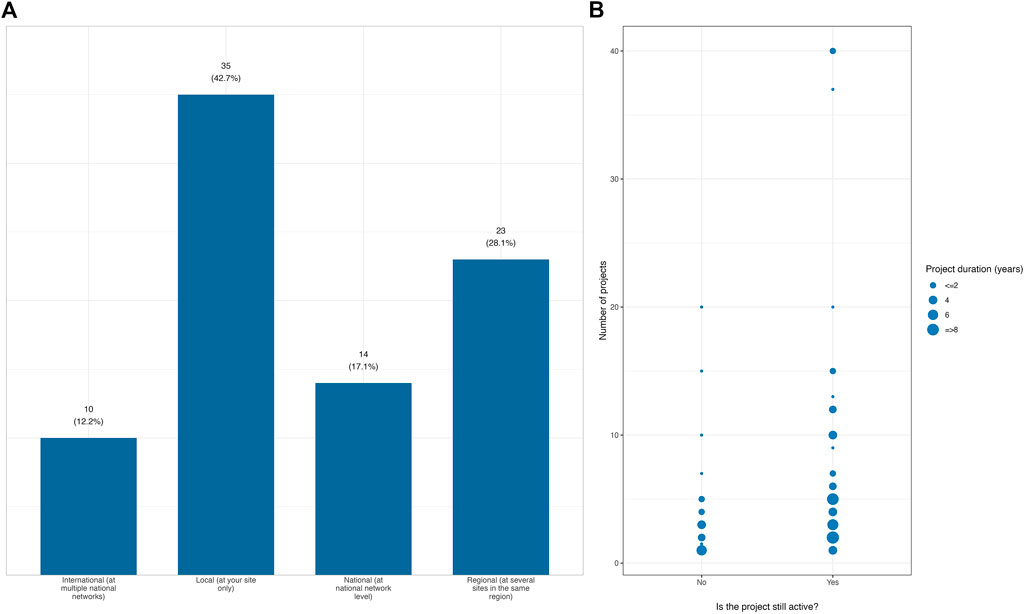
FIGURE 4. CS initiatives: percentage of responses for the different spatial scales (A) and information on duration and state of activity of the projects (B).
3.2.2 Volunteers’ involvement
The volunteers participating in the CS initiatives were mainly adults (43%) with 17% being involved through an organized group (e.g., birding clubs, groups of divers) (Figure 6A). Eighteen percent were children participating as part of school (12%) or out-of-school (6%) programs. The remaining 30% were undergraduate students (11%), seniors (11%) and families (8%). Fifty-three percent of the volunteers were part of underserved communities living in rural areas (21%) or with limited financial resources (21%) (Figure 6B).
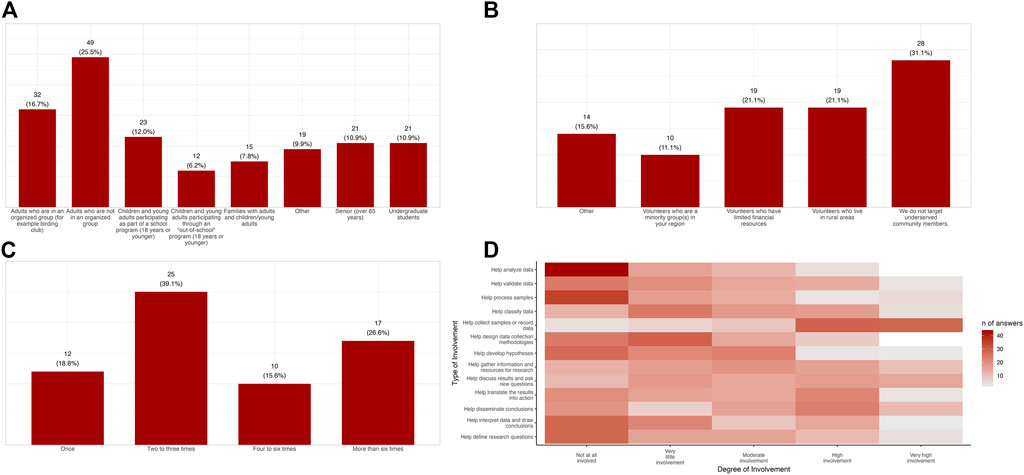
FIGURE 6. Percentage of responses for the different types of volunteers involved in the CS initiatives (A), the engaged underserved communities (B), the frequency of participation of volunteers (C), and the degree of involvement of volunteers in the different activities (D).
Eighty-one percent of the volunteers had participated two or more times in the same initiative (Figure 6C). The most common type of volunteer involvement was to “help collect samples and record data” (75% of the respondents’ rated this as “high” and “very high”). Some respondents also gave “high” and “very high” to the following types of involvement: “help disseminate conclusions” (44%), “help discuss results and ask new questions” (42%), “help gather information and resources for research” (34%), and “help translate the results into action” (33%). Least common were involving volunteers in “helping design data collection methodologies” (11%), “helping to develop hypotheses” (7%), and “helping to analyze data” (5%). Similar results were apparent in responses to the open-response question: “What do volunteers do in your selected citizen science initiative?“; that is, 60% of the listed activities were collection of samples and sightings, as well as mapping of animals and plants species distribution (Figure 6D). Ninety-seven percent of the volunteers were trained or supported in some way for participation in these initiatives (Figure 7), and this was primarily via mandatory or voluntary short face-to-face workshops (44%) or via written instructions (33%).
3.2.3 Citizen science data and findings
Respondents declared that, in their initiatives, volunteers collected numeric and Boolean data (37%), images (20%), geographic information (20%) and text (17%) (Figure 8A). Ninety-eight percent of the data from the initiatives were validated in some ways; this validation was by scientists (40%), other volunteers (10%) or by using other methods and term of comparison (48%) (Figure 8B). Some initiatives shared research data with volunteers through online repositories (61%) (Figure 8C), while many share research findings with the volunteers (95%) mainly during in-person meetings (50%), as well as through online direct communications, such as email (19%) and indirect communications (15%), such as newsletters and reports (Figure 9A). Ninety-seven percent of the initiatives acknowledged the volunteers in reports or journal articles via the acknowledgment section (50%) or by describing their contribution in the material and methods section (27%); occasionally they were listed as coauthors (13%) (Figure 9B).
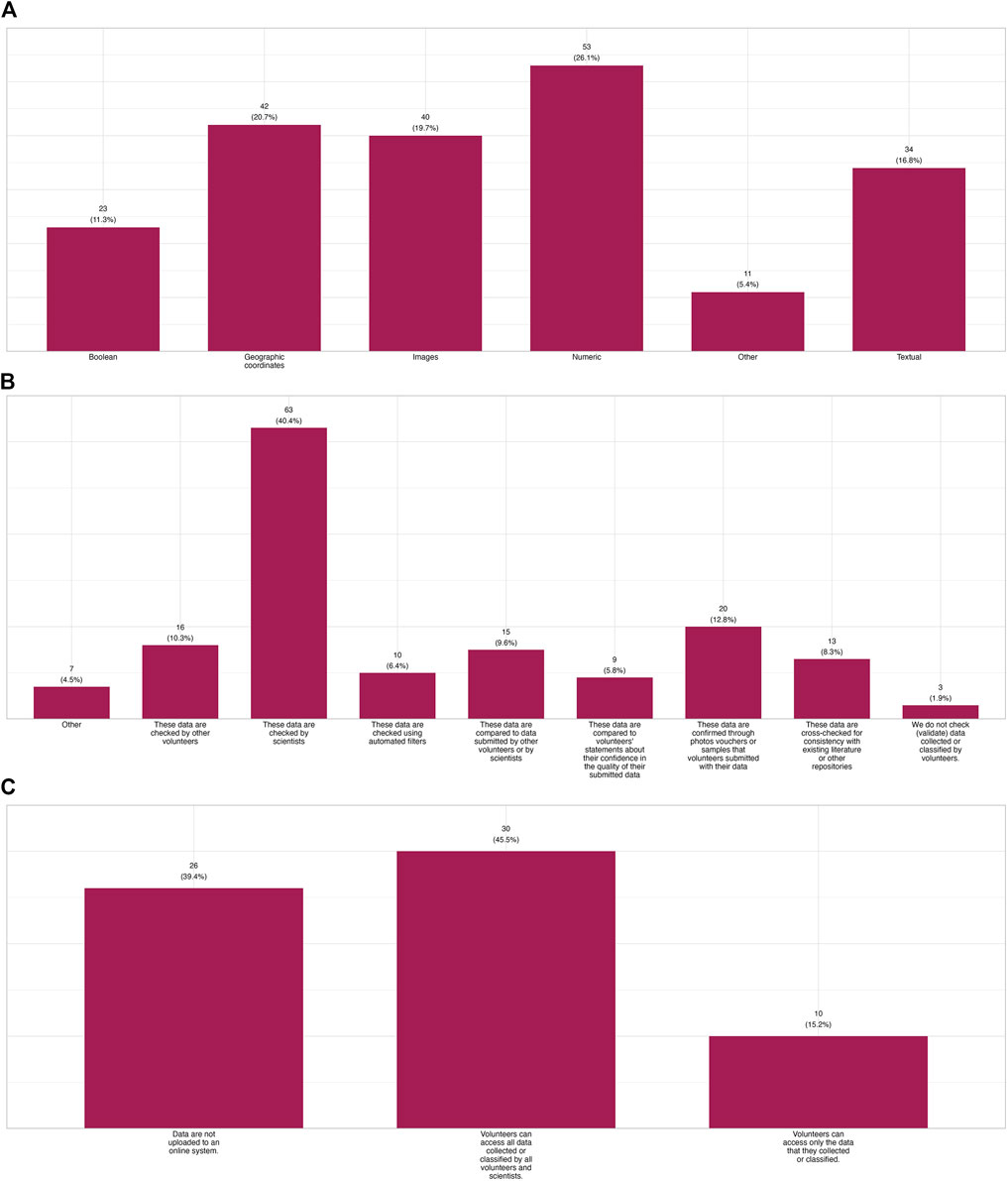
FIGURE 8. Percentage of responses for the different types of data collected from the initiatives (A), the quality check procedures (B), and the methods to share data (C).
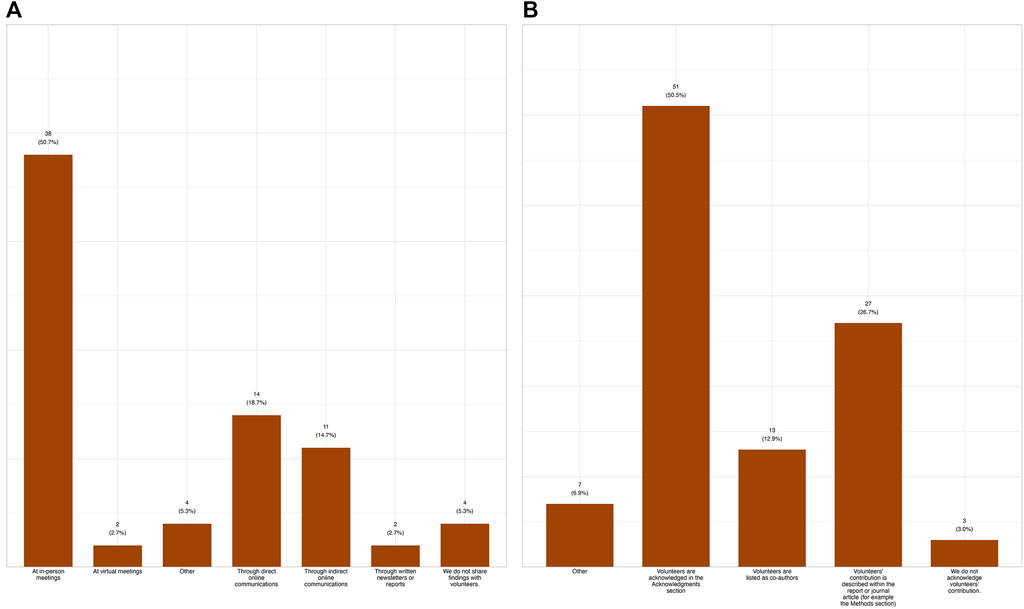
FIGURE 9. Percentage of responses for the different ways to share projects outcomes (A) and to acknowledge volunteers (B).
4 Discussion
The main aim of this paper was to examine CS practices of scientists working at ILTER sites and platforms across the globe. ILTER sites and platforms offer the opportunity to explore various dimensions of CS across a wide range of different geographic, cultural and socio-ecological contexts and in the context of the interests to multiple stakeholders and at different scales. In this study, we examined the main features of CS initiatives in which ILTER scientists are/were involved (i.e., spatial and temporal scale, research foci, type of volunteers, type of data collected and quality check, training methodologies and ways to share data and findings) and the level of involvement of the volunteers in these initiatives.
In general, our findings show that the responding ILTER scientists were open to adopting and promoting CS; indeed, approximately half of respondents have participated in CS initiatives with many involved in more than one during their scientific career. The involvement in CS initiatives did not seem affected by the respondents’ demographic and geographic provenance. This could be mainly due to the distribution of respondents to our questionnaire, which was biased to staff who are senior/mid-career and over 50 years and working in regions with higher economic density (Wohner et al., 2021).
In the following sections, we will discuss the six main features of the ILTER CS initiatives described by the questionnaire respondents in the context of the international framework of the “Ten Principles of Citizen Science (ECSA, 2015; Eitzel et al., 2017; Robinson et al., 2018), which we organized into the three overarching categories: i) Scientific outcomes and societal/policy impact, ii) Type of volunteers involvement, iii) Sharing of data and findings, feedbacks and acknowledgements (see Table 1; Figure 2).
4.1 Scientific outcomes and societal/policy impact
CS initiatives have a genuine science outcome, and this distinguishes them from purely education and outreach programs (Bonney et al., 2009). At the same time, it is very relevant their—real or potential—societal and policy impacts, even though this is not always properly developed and evaluated (Robinson et al., 2018; Turbè et al., 2019; Stylinski et al., 2020).
As expected from the conceptual background and overall motivations of the ILTER network (Mirtl et al., 2018), the main research foci of the ILTER CS initiatives were biology and environmental science. The scientific questions addressed biodiversity, mainly the distribution of specific groups of organisms, but also water quality, ecosystem services and climate change (e.g., effects, mitigation). The ILTER community seems therefore to diverge, at least partially, from what is reported by reviews of environmental CS projects in other context, where the monitoring of biodiversity dominates (Schade and Tsinaraki, 2016; Pocock et al., 2017; Hecker et al., 2018; Turbè et al., 2019). Indeed, ILTER CS initiatives focusing on the ecological state and on the use of natural resources (air, water, land), and on ecosystem services and environmental management, conservation and protection are fairly well represented.
All the initiatives described in the questionnaire are potentially relevant for addressing a number of policy and conservation issues, such as biodiversity targets achievement and environmental Directives implementation. Furthermore, research conducted at the ILTER sites and platforms often addresses critical questions regarding natural resources management so that the data and knowledge produced are fundamental and irreplaceable for documenting long-term trends in environmental conditions and making for policy decisions at the local, regional and global levels (Hughes et al., 2017; Mirtl et al., 2018). In particular, ILTER may play a major role in global monitoring and evaluation frameworks, such as the Aichi targets, the UN SDGs, and the Sendai Framework. Given this, the involvement of citizen scientists into the scientific processes has the potential to increase policy impacts of ILTER studies. Overall, CS is emerging as a practice that effectively contributes to all the aspects of the policy process (Turbè et al., 2019); this includes carrying out research at scales that would not have been possible otherwise and early detection of a range of environmental issues, as well as highlighting new issues for decision makers and promoting policy implementation through CS monitoring programmes. However, it can be arduous to evaluate the uses of findings for policy and decision-making or to attribute this use to a specific policy area (e.g., Hyder et al., 2015; Turbè et al., 2019). ILTER could be in the position to reinforce the effectiveness of CS for policy, mostly by fostering CS projects that collect data over broad spatial and temporal scales, so that policymakers would have evidence-based knowledge that can be used to serve multiple objectives and meet current and future policy objectives. Most ILTER CS initiatives reported here do not contain these characteristics; that is, they are primarily implemented at the local scale (at one LTER site only) or, more rarely, at the regional scale (at several LTER sites in the same region) and are short-term with a mean duration of 4 years. Thus, a key value of ILTER (i.e., its broad-scale) does not emerge from our study. This is very likely the consequence of the lack of harmonized views, guidelines and dedicated funding for CS at ILTER. This leaves to each site or network own responsibility for running the project, bringing the constraints typical of short-term projects, failing the target to create and sustain a stable long-term citizen engagement.
At the same time, ILTER sites are in the position to powerfully address local scale, community-based initiatives to support not only science, but also policy and community actions, through co-designed or bottom-up projects. However, as described in the next paragraph, less than 10% of volunteers are engaged in the stage of CS project design, definition of hypothesis and data analysis: there is still much to be done to include citizen participation in all steps of the scientific process and to realize the full social potential of CS in terms of citizen empowerment and transformative capacity.
4.2 Types of volunteers’ involvement
The patterns of volunteer participating in CS activities may give important clues about the level of representativeness of the wider society in science and about possible bias concerning age, gender, education, socio-economic status and other factors in CS overall (National Academies of Sciences, 2018; Pateman et al., 2021). CS initiatives often engage volunteers who are prevalently men, people identifying as from white ethnic groups, have high socio-economic status, and are in education at school, college, or university (Pateman et al., 2021). Surprisingly, participating ILTER scientists report that more than 50% of their volunteers are members of underserved communities, in particular those living in rural areas and having limited financial resources. A likely explanation is that most LTER sites are located in natural/rural areas (Wohner et al., 2021), where the local communities may fall mainly into the “underserved” category. The involvement of this kind of volunteer suggests that ILTER CS studies are potentially able to incorporate place-based knowledge provided by volunteers into the scientific process.
Almost two-thirds of the respondents stated that the volunteers are involved mainly in “helping collect samples or record data.” Less than 10% of volunteers are engaged in the project design phase, definition of hypothesis and data analysis. This matches other studies (e.g., Phillips et al., 2018; Turrini et al., 2018; Stylinski et al., 2020); it limits opportunities for a meaningful dialogue between science and society, which could foster a greater sense of ownership among volunteers and benefit the research by incorporating local knowledge and expertise (Corburn, 2007). There are likely a number of reasons for this result. For example, scientists may maintain more traditional views of public engagement outcomes (e.g., focused on knowledge gains rather than mutual exchanges), or they may perceive data collection support aligns best with the research needs and ways in which volunteers can realistically contribute (Gray et al., 2017). That said, a large percentage of the ILTER scientists (30%–40%) listed several other types of involvement of volunteers, including dissemination of the project conclusions, discussion and translation of the results into action and applying them to new questions. This indicates that some ILTER scientists have a broader view of the volunteers’ contribution and greater commitment to more collaborative aspects of CS; this was also apparent in findings reported in L’Astorina et al., 2023.
Almost the totality of the volunteers in ILTER initiatives were trained using a variety of methods, such as face-to-face workshops, written instructions, and online tutorials. This is noteworthy since an appropriate degree of structured training is considered one of the essential characteristics of CS (Haklay et al., 2021) and one of the ways to ensure high data quality (Kosmala et al., 2016), while also meeting education goals of CS efforts. Training of citizens should lay the essential foundations for the good quality of the data gathered, even though the leaders of the CS initiatives will always have the responsibility to control, measure and report data quality and quality assurance procedures to demonstrate the validity and reliability of the data (Williams et al., 2018). This will also help to overcome one of the barriers that hampers the integration of CS into policy, that is the concern about data quality, interoperability, and access, and mistrust of non-traditional data sources (Kosmala et al., 2016; Balázs et al., 2021).
4.3 Sharing of data and findings, feedbacks and acknowledgements
Data reliability and data quality in CS projects has been and continues to be discussed within the scientific community (e.g., Galloway et al., 2006; Silvertown, 2009; Hunter et al., 2013; Kosmala et al., 2016; Balázs et al., 2021) and is considered to be the main barrier to engaging scientists in CS projects (e.g., Riesch et al., 2013; Burgess et al., 2017; Golumbic et al., 2017).
For the ILTER CS initiatives, there is room for improvement in terms of the data accessibility, as less than half of the CS initiatives make the data produced fully accessible through online repositories after being validated by experts. Considering the growing tendency of the ILTER community to embrace an open science approach, following the expectations of a global research infrastructure (Mirtl et al., 2018), further steps are required to increase the dissemination of best practices for the promotion of open access and the set-up of adequate data infrastructure. ILTER could foster centralized access to the CS resources, creating a data and knowledge platform, which could also allow sharing tools and best practices all over the network with harmonized and interoperable metadata and data standards.
Questionnaire respondents most often reported sharing research findings with CS volunteers and other stakeholders via in-person meeting or informal online media only (e.g., reports, newsletters, email), which is congruent with outcomes from other studies (Theobald et al., 2015; Kullenberg and Kasperowski, 2016; Burgess et al., 2017; Turrini et al., 2018). Results published through these channels are relevant, since they may reach important local stakeholders; however, the rarer use of scientific publication, could preclude CS from really fulfilling the goal of advancing science as well as gaining grounds in more traditionally oriented research organizations.
When publishing peer-reviewed publications from their CS projects, almost all of the ILTER scientists cited their volunteers directly in the acknowledgments or by describing their contribution in the material and methods; a few even listed them as coauthors. Overall, this is an encouraging result, since it is proved that giving good feedbacks may provide many benefits (Robinson et al., 2018 and reference therein); in particular, it is a way to show volunteers that their contribution is meaningful, providing motivations for participation in other projects and reinforcing connection and trust between citizen scientists and professional scientists. It would be particularly useful to help improve the practice of CS scientists to describe how they recruited, trained, supported and provided benefits to volunteers in the methods section of their scientific papers (Davis et al., 2022).
5 Final remarks
The ILTER community demonstrated a good predisposition toward environmentally-focused CS initiatives. Hereafter, we try to summarize the outcomes emerged from our work into a set of key final remarks and suggestions.
Efforts should be made to develop initiatives that involve volunteers in ways that extend beyond data collection. Environmental CS has multiple applications and a vast range of experiences and best practices has been so far accumulated, which make it possible to go beyond the simple collection of observations. As reported in the study by L’Astorina et al., 2023, the ILTER community has broad views on how CS volunteers can contribute to science research and is open to a wide array of possible outcomes including learning from local community members. There is still much to be done to include citizen participation in all steps of the scientific process and to realize the full social potential of CS in terms of citizen empowerment and transformative capacity.
Careful consideration should be given to the scientific, educational and societal/policy outcomes of a CS initiative to properly undertake specific steps to broaden the diversity of volunteers, setting up appropriate recruitment methods, which should start since the early stages of the project planning, in a truly and effective co-designed process.
The connections between CS and policies in ILTER should be improved, considering the huge potential of CS for policy. Useful recommendations were proposed by Turbè et al. (2019), and they could represent key inputs for the integration of CS in the environmental policy cycle. In particular, scientists at ILTER sites and platforms are in the position to lead local scale, community-based initiatives to support policy and community actions, through co-designed or bottom-up projects. Moreover, being ILTER a network of sites, the value of CS initiatives at “local” level has an intrinsic importance, since it allows incorporating local, place-based knowledge into the scientific process. Indeed, leveraging the “power of place” (as defined and analyzed by Newman et al., 2017) could generate substantial impacts on decision making (e.g., with regards to conservation and management of the land, and fostering participation and negotiation).
Taking advantage of its worldwide distribution, the ILTER community should also work to implement CS initiatives with a larger spatial scale, fostering research between different national networks and on a global scale. Surprisingly, the broad-scale and long-term features of ILTER sites and platforms did not emerge from our study. The lack of harmonized views and guidelines for CS means each LTER site and platform is responsible for running their projects, hampering the creation of a stable long-term citizen engagement.
As with all research, data management plans should be prepared, considering the peculiarity of CS and the different steps of the data cycle from collection to preservation, in order to ensure data reproducibility and reuse (Fraisl et al., 2022). Any data management system would be enriched with data on volunteers (e.g., demographic data, numbers of times they have contributed data, training approaches, evaluation efforts) that is coupled with submission by volunteers (Peterman et al., 2022). ILTER could create a data and knowledge platform dedicated to the access to CS resources, for sharing tools and best practices all over the network, with harmonized and interoperable methods and standards.
Data availability statement
The datasets presented in this study can be found in online repositories. The names of the repository/repositories and accession number(s) can be found below: https://doi.org/10.5281/zenodo.7148596 https://doi.org/10.5281/zenodo.7472885.
Ethics statement
Ethical review and approval was not required for the study on human participants in accordance with the local legislation and institutional requirements. Written informed consent for participation was not required for this study in accordance with the national legislation and the institutional requirements.
Author contributions
All the Authors contributed to the design of the research and were organizers of the preparatory workshop during the ILTER 2nd Open Science Meeting (Leipzig, Germany; 3rd of September 2019); CD, CB, AL’A, and AC drafted the questionnaire, which was discussed with and approved by all the authors; AO and CB elaborated the questionnaire results. CB, AP, AC, and AO drafted the manuscript. All the Authors contributed to the discussion of the results and to the critical revisions of the text.
Funding
This work was performed within the “Citizens for Long-Term Ecological Research” initiative, supported by the ILTER Initiative Grants.
Acknowledgments
We acknowledge the ILTER Coordination Committee and Secretariat for contributing to sharing widely the questionnaire within the whole network and all the respondents of the ILTER community for their availability to participate.
Conflict of interest
The authors declare that the research was conducted in the absence of any commercial or financial relationships that could be construed as a potential conflict of interest.
Publisher’s note
All claims expressed in this article are solely those of the authors and do not necessarily represent those of their affiliated organizations, or those of the publisher, the editors and the reviewers. Any product that may be evaluated in this article, or claim that may be made by its manufacturer, is not guaranteed or endorsed by the publisher.
Supplementary material
The Supplementary Material for this article can be found online at: https://www.frontiersin.org/articles/10.3389/fenvs.2023.1130020/full#supplementary-material
Supplementary Material | Survey provided to the ILTER community on scientists’ perspectives and activities associated with citizen science and other forms of public engagement.
Footnotes
1http://www.globalcitizenscience.org.
4DEIMS.iD is the identifier of ILTER sites/platforms on Dynamic Ecological Information Management System - Site and dataset registry (DEIMS-SDR), which is the ILTER information management system that allows to discover long-term ecosystem research sites around the globe. https://deims.org/docs/deimsid.html.
References
Aceves-Bueno, E., Adeleye, A. S., Bradley, D., Tyler Brandt, W., Callery, P., Feraud, M., et al. (2015). Citizen science as an approach for overcoming insufficient monitoring and inadequate stakeholder buy-in in adaptive management: Criteria and evidence. Ecosystems 18, 493–506. doi:10.1007/s10021-015-9842-4
Balázs, B., Mooney, P., Nováková, E., Bastin, L., and Jokar Arsanjani, J. (2021). “Data quality in citizen science,” in The science of citizen science. K. Vohland, A. Land-Zandstra, L. Ceccaroni, R. Lemmens, J. Perelló, and M. Ponti (Cham: Springer). doi:10.1007/978-3-030-58278-4_8
Ballard, H. L., Dixon, C. G. H., and Harris, E. M. (2017). Youth-focused citizen science: Examining the role of environmental science learning and agency for conservation. Biol. Conserv. 208, 65–75. doi:10.1016/j.biocon.2016.05.024
Bergami, C., Merritt Davis, C., Campanaro, A., Pugnetti, A., L'Astorina, A., and Oggioni, A. (2022). Survey dataset - environmental citizen science: Practices and scientists' attitudes at ILTER (1.0). Zenodo. doi:10.5281/zenodo.7148596 Available at: https://zenodo.org/
Besley, J. C., Dudo, A., Yuan, S., and Lawrence, F. (2018). Understanding scientists’ willingness to engage. Sci. Commun. 40 (5), 559–590. doi:10.1177/1075547018786561
Bonney, R., Cooper, C. B., Dickinson, J., Kelling, S., Phillips, T., Rosenberg, K. V., et al. (2009). Citizen science: A developing tool for expanding science knowledge and scientific literacy. BioScience 59, 977–984. doi:10.1525/bio.2009.59.11.9
Bonney, R., Phillips, T. B., Ballard, H. L., and Enck, J. W. (2016). Can citizen science enhance public understanding of science? Public Underst. Sci. 25 (1), 2–16. doi:10.1177/0963662515607406
Branchini, S., Meschini, M., Covi, C., Piccinetti, C., Zaccanti, F., and Goffredo, S. (2015). Participating in a citizen science monitoring program: Implications for environmental education. PLOS ONE 10 (7), e0131812. doi:10.1371/journal.pone.0131812
Burgess, H. K., DeBey, L. B., Froehlich, H. E., Schmidt, N., Theobald, E. J., Ettinger, A. H., et al. (2017). The science of citizen science: Exploring barriers to use as a primary research tool. Biol. Conserv. 208, 113–120. doi:10.1016/j.biocon.2016.05.014
Chandler, M., See, L., Copas, K., Bonde, A. M., López, B. C., Danielsen, F., et al. (2017). Contribution of citizen science towards international biodiversity monitoring. Biodivers. Conserv. 213, 280–294. doi:10.1016/j.biocon.2016.09.004
Chapman, C., and Hodges, C. (2017). “Can citizen science seriously contribute to policy development? A decision maker’s view,” in Analyzing the role of citizen science in modern research. Editors L. Ceccaroni, and J. Piera (Hershey, PA: IGI Global), 246–261. doi:10.4018/978-1-5225-0962-2.ch012
Corburn, J. (2007). Community knowledge in environmental health science: Co-producing policy expertise. Environ. Sci. Policy 10 (2), 150–161. doi:10.1016/j.envsci.2006.09.004
Davis, C., Weber, C., and Nadkarni, N. (2022). Prevalence of discourse on public engagement with science in ecology literature. Front. Ecol. Environ. 20, 524–530. doi:10.1002/fee.2535
Dick, J., Orenstein, D. E., Holzer, J. M., Wohner, C., Achard, A. L., Andrews, C., et al. (2018). What is socio-ecological research delivering? A literature survey across 25 international LTSER platforms. Sci. Total Environ. 622-623, 1225–1240. doi:10.1016/j.scitotenv.2017.11.324
Dudo, A., and Besley, J. C. (2016). Scientists’ prioritization of communication objectives for public engagement. PLoS One 11 (2), e0148867. doi:10.1371/journal.pone.0148867
ECSA (2015). Ten principles of citizen science. Berlin: European Citizen Science Association. doi:10.17605/OSF.IO/XPR2N
EEA (2021a). Living in a state of multiple crises: Health, nature, climate, economy, or simply systemic unsustainability? Berlin: European Environment Agency.
Eitzel, M. V., Cappadonna, J. L., Santos-Lang, C., Duerr, R. E., Virapongse, A., West, S. E., et al. (2017). Citizen science terminology matters: Exploring key terms. Citiz. Sci. Theory Pr. 2, 1. doi:10.5334/cstp.96
Fraisl, D., Campbell, J., See, L., Wehn, U., Wardlaw, J., Gold, M., et al. (2020). Mapping citizen science contributions to the UN sustainable development goals. Sustain Sci. 15, 1735–1751. doi:10.1007/s11625-020-00833-7
Fraisl, D., Hager, G., Bedessem, B., Gold, M., Hsing, P. Y., Danielsen, F., et al. (2022). Citizen science in environmental and ecological sciences. Nat. Rev. Methods Prim. 2, 64. doi:10.1038/s43586-022-00144-4
Fritz, S., See, L., Carlson, T., Haklay, M. M., Oliver, J. L., Fraisl, D., et al. (2019). Citizen science and the United Nations sustainable development goals. Nat. Sustain. 2 (10), 922–930. doi:10.1038/s41893-019-0390-3
Galloway, A. W. E., Tudor, M. T., and Vander Haegen, W. M. (2006). The reliability of citizen science: A case study of Oregon white oak stand surveys. Wildl. Soc. Bull. 34, 1425–1429. doi:10.2193/0091-7648(2006)34[1425:trocsa]2.0.co;2
Garcia-Soto, C., Seys, J. J., Zielinski, O., Busch, J. A., Luna, S. I., Baez, J. C., et al. (2021). Marine citizen science: Current state in Europe and new technological developments. Front. Mar. Sci. 8, 241. doi:10.3389/fmars.2021.621472
Geijzendorffer, I. R., Regan, E. C., Pereira, H. M., Brotons, L., Brummitt, N., Gavish, Y., et al. (2016). Bridging the gap between biodiversity data and policy reporting needs: An essential biodiversity variables perspective. J. Appl. Ecol. 53, 1341–1350. doi:10.1111/1365-2664.12417
Golumbic, Y. N., Orr, D., Baram-Tsabari, A., and Fishbain, B. (2017). Between vision and reality: A study of scientists’ views on citizen science. Citiz. Sci. Theory Pract. 2 (1), 1–13. doi:10.5334/cstp.53
Gray, S., Jordan, R., Crall, A., Newman, G., Hmelo-Silver, C., Huang, J., et al. (2017). Combining participatory modelling and citizen science to support volunteer conservation action. Biol. Conserv. 208, 76–86. doi:10.1016/j.biocon.2016.07.037
Greenwood, J. J. (2007). Citizens, science and bird conservation. J. Ornithol. 148, 77–124. doi:10.1007/s10336-007-0239-9
Groffman, P. M., Stylinski, C., Nisbet, M. C., Duarte, C. M., Jordan, R., Burgin, A., et al. (2010). Restarting the conversation: Challenges at the interface between ecology and society. Front. Ecol. Environ. 8 (6), 284–291. doi:10.1890/090160
Haberl, H., Winiwarter, V., Andersson, K., Ayres, R. U., Boone, C., Castillo, A., et al. (2006). From LTER to LTSER: Conceptualizing the socio-economic dimension of long-term socio-ecological research. Ecol. Soc. 11 (2), 13. doi:10.5751/es-01786-110213
Haklay, M. (2013). “Citizen science and volunteered geographic information: Overview and typology of participation,” in Crowdsourcing geographic knowledge. Editors D. Sui, S. Elwood, and M. Goodchild (Dordrecht: Springer), 105–122. doi:10.1007/978-94-007-4587-2_7
Haklay, M., Fraisl, D., and Tzovaras, B. G. (2021). Contours of citizen science: A vignette study. R. Soc. Open Sci. R. Soc. 8 (8), 108. doi:10.1098/rsos.202108
Haklay, M. (2017). “The three eras of environmental information: The roles of experts and the public,” in Participatory sensing, opinions and collective awareness. Understanding complex systems. Editor V. Loreto (Cham: Springer).
Halliwell, P., Whipple, S., and Bowser, G. (2021). Learning to love protected areas: Citizen science projects inspire place attachment for diverse students in United States national parks. J. Geosci. Educ. 1, 412–420. doi:10.1080/10899995.2021.1947115
Hecker, S., Bonney, R., Haklay, M., Hölker, F., Hofer, H., Goebel, C., et al. (2018). Innovation in citizen science – perspectives on science-policy advances. Citiz. Sci. Theory Pract. 3 (1), 1–14. doi:10.5334/cstp.114
Hochachka, W. M., Fink, D., Hutchinson, R. A., Sheldon, D., Wong, W-K., and Kelling, S. (2011). Data-intensive science applied to broad-scale citizen science. Trends Ecol. Evol. 27 (2), 130–137. doi:10.1016/j.tree.2011.11.006
Hughes, B. B., Beas-Luna, R., Barner, A. K., Brewitt, K., Brumbaugh, D. R., Cerny-Chipman, E. B., et al. (2017). Long-term studies contribute disproportionately to ecology and policy. Long-Term Stud. Contribute Disproportionately Ecol. Policy Biosci. 67 (3), 271–281. doi:10.1093/biosci/biw185
Hunter, J., Alabri, A., and Ingen, C. (2013). Assessing the quality and trustworthiness of citizen science data. Concurr. Comput. Pract. Exp. 25, 454–466. doi:10.1002/cpe.2923
Hyder, K., Townhill, B., Anderson, L. G., Delany, J., and Pinnegar, J. K. (2015). Can citizen science contribute to the evidence-base that underpins marine policy? Mar. Policy 59, 112–120. doi:10.1016/j.marpol.2015.04.022
Kosmala, M., Wiggins, A., Swanson, A., and Simmons, B. (2016). Assessing data quality in citizen science. Front. Ecol. Environ. 14, 551–560. doi:10.1002/fee.1436
Kullenberg, C., and Kasperowski, D. (2016). What is citizen science? A scientometric metaanalysis. PLoS One 11, e0147152. doi:10.1371/journal.pone.0147152
L’Astorina, A., Davis, C., Pugnetti, A., Campanaro, A., Oggioni, A., and Bergami, C. (2023). Scientists’ attitudes about citizen science at Long-Term Ecological Research (LTER) sites. Front. Environ. Sci. -Environmental Citizen Science 11. doi:10.3389/fenvs.2023.1130022 Available at: https://www.frontiersin.org/articles/10.3389/fenvs.2023.1130022
Lidskog, R. (2008). Scientised citizens and democratised science. Re-assessing the expert-lay divide. J. Risk Res. 11 (1–2), 69–86. doi:10.1080/13669870701521636
Mauz, I., Peltola, T., Granjou, C., van Bommel, S., and Buijs, A. (2012). How scientific visions matter: Insights from three long-term socio-ecological research (LTSER) platforms under construction in Europe. Environ. Sci. Policy 19, 90–99. doi:10.1016/j.envsci.2012.02.005
Miller-Rushing, A., Primack, R., and Bonney, R. (2012). The history of public participation in ecological research. Front. Ecol. Environ. 10, 285–290. doi:10.1890/110278
Mirtl, M., Borer, T. E., Djukic, I., Forsius, M., Haubold, H., Hugo, W., et al. (2018). Genesis, goals and achievements of long-term ecological research at the global scale: A critical review of ilter and future directions. Sci. total Environ. 626, 1439–1462. doi:10.1016/j.scitotenv.2017.12.001
National Academies of Sciences (2018). Learning through citizen science: Enhancing opportunities by design. Washington, DC: The National Academies Press. doi:10.17226/25183Engineering, and medicine
Newman, G., Chandler, M., Clyde, M., McGreavy, B., Haklay, M., Ballard, H., et al. (2017). Leveraging the power of place in citizen science for effective conservation decision making. Biol. Conserv. 208, 55–64. doi:10.1016/j.biocon.2016.07.019
Oggioni, A., and Bergami, C. (2022). oggioniale/CSSurveyAnalysis: 1.0 (1.0). Zenodo. doi:10.5281/zenodo.7472885 Available at: https://zenodo.org/
Olson, D. M., Dinerstein, E., Wikramanayake, E. D., Burgess, N. D., Powell, G. V. N., Underwood, E. C., et al. (2001). Terrestrial ecoregions of the world: A new map of life on earth. BioScience 51 (11), 933–938. doi:10.1641/0006-3568(2001)051[0933:teotwa]2.0.co;2
Owen, R., and Parker, A. (2018). “Citizen science in environmental protection agencies (Chapter 20),” in Citizen science: Innovation in open science, policy and society (Berlin: European Citizen Science Association), 284–300. doi:10.2307/j.ctv550cf2.27
Pateman, R., Dyke, A., and West, S. (2021). The diversity of participants in environmental citizen science. Citiz. Sci. Theory Pract. 6 (1), 9. doi:10.5334/cstp.369
Peterman, K., Del Bianco, V., Grover, A., Davis, C., and Rosser, H. (2022). Hiding in plain sight: Secondary analysis of data records as a method for learning about citizen science projects and volunteers’ skills. Citiz. Sci. Theory Pract. 7 (1), 35. doi:10.5334/cstp.476
Phillips, T., Porticella, N., Constas, M., and Bonney, R. (2018). A framework for articulating and measuring individual learning outcomes from participation in citizen science. Citiz. Sci. Theory Pract. 3 (2), 3. doi:10.5334/cstp.126
Pocock, M. J. O., Tweddle, J. C., Savage, J., Robinson, L. D., and Roy, H. E. (2017). The diversity and evolution of ecological and environmental citizen science. PLOS ONE 12 (4), e0172579. doi:10.1371/journal.pone.0172579
R Core Team (2021). R: A language and environment for statistical computing. Vienna, Austria: R Foundation for Statistical Computing. Avaliable At: https://www.R-project.org/.
Riesch, H., Potter, C., and Davies, L. (2013). Combining citizen science and public engagement: The open air laboratories programme. JCOM 12 (03), A03. doi:10.22323/2.12030203
Robertson Evia, J., Peterman, K., Cloyd, E., and Besley, J. (2018). Validating a scale that measures scientists’ self-efficacy for public engagement with science. Int. J. Sci. Educ. Part B 8 (1), 40–52. doi:10.1080/21548455.2017.1377852
Robinson, L., Cawthray, J. L., West, S. E., Bonn, A., and Ansine, J. (2018). “10 principles of citizen science,” in Citizen science: Innovation in open science, society and policy. Editors S. Hecker, M. Haklay, A. Bowser, Z. Makuch, J. Vogel, and A. Bonn (London: UCL Press), 27–40.
Rubio-Iglesias, J. M., Edovald, T., Grew, R., Kark, T., Kideys, A. E., Peltola, T., et al. (2020). Citizen science and environmental protection agencies: Engaging citizens to address key environmental challenges. Front. Clim. 2. doi:10.3389/fclim.2020.600998
Schade, S., and Tsinaraki, C. (2016). European commission and joint research centre. (2016). Survey report: Data management in citizen science projects. EUR 27920 EN. Luxembourg: Publications Office of the European Union.
Scott, A., Jeon, S-H., Joyce, C. M., Humphreys, J. S., Kalb, G., Witt, J., et al. (2011). A randomised trial and economic evaluation of the effect of response mode on response rate, response bias, and item non-response in a survey of doctors. BMC Med. Res. Methodol. 11 (1), 126. doi:10.1186/1471-2288-11-126
Shirk, J. L., Ballard, H. L., Wilderman, C. C., Phillips, T., Wiggins, A., Jordan, R., et al. (2012). Public participation in scientific research: A framework for deliberate design. Ecol. Soc. 17, 29. doi:10.5751/ES-04705-170229
Silvertown, J. (2009). A new dawn for citizen science. Trends Ecol. Evol. 24 (9), 467–471. doi:10.1016/j.tree.2009.03.017
Singh, S. J., Haberl, H., Chertow, M., Mirtl, M., and Schmid, M. (2013). Long term socio-ecological research: Studies in society-nature interactions across spatial and temporal scales. Dordrecht: Springer, 1–26.
Stylinski, C. D., Peterman, K., Phillips, T., Linhart, J., and Becker-Klein, R. (2020). Assessing science inquiry skills of citizen science volunteers: A snapshot of the field. Int. J. Sci. Educ. Part B 10 (1), 77–92. doi:10.1080/21548455.2020.1719288
Stylinski, C., Storksdieck, M., Canzoneri, N., Klein, E., and Johnson, A. (2018). Impacts of a comprehensive public engagement training and support program on scientists’ outreach attitudes and practices. Int. J. Sci. Educ. Part B 8 (4), 340–354. doi:10.1080/21548455.2018.1506188
Theobald, E. J., Ettinger, A. K., Burgess, H. K., DeBey, L. B., Schmidt, N. R., Froehlich, H. E., et al. (2015). Global change and local solutions: Tapping the unrealized potential of citizen science for biodiversity research. Biol. Conserv. 181, 236–244. doi:10.1016/j.biocon.2014.10.021
Tredick, C. A., Lewison, R. L., Deutschman, D. H., Hunt, T. A., Gordon, K. L., and Von Hendy, P. (2017). A rubric to evaluate citizen-science programs for long-term ecological monitoring. BioScience 67 (9), 834–844. doi:10.1093/biosci/bix090
Turbé, A., Barba, J., Pelacho, M., Mugdal, S., Robinson, L., Serrano-Sanz, F., et al. (2019). Understanding the citizen science landscape for European environmental policy: An assessment and recommendations. Citiz. Sci. Theory Pract. 4 (4), 34. doi:10.5334/cstp.239
Turrini, T., Dörler, D., Richter, A., Heigl, F., and Bonn, A. (2018). The threefold potential of environmental citizen science - generating knowledge, creating learning opportunities and enabling civic participation. Biol. Conserv. 225, 176–186. doi:10.1016/j.biocon.2018.03.024
Vohland, K., Land-Zandstra, A., Ceccaroni, L., Lemmens, R., Perelló, J., Ponti, M., et al. (2021). “The science of citizen science evolves. chapter 1,” in The science of citizen science. K. Vohland, A. Land-Zandstra, L. Ceccaroni, R. Lemmens, J. Perelló, and M. Ponti (Cham: Springer), 1–12. doi:10.1007/978-3-030-58278-4_1
Williams, J., Chapman, C., Leibovici, D., Loïs, G., Matheus, A., Oggioni, A., et al. (2018). “Maximising the impact and reuse of citizen science data,” in Citizen science – innovation in open science, society and policy. Editors S. Hecker, M. Haklay, A. Bowser, Z. Makuch, J. Vogel, and A. Bonn (London: UCL Press), 321–336.
Wohner, C., Ohnemus, T., Zacharias, S., Mollenhauer, H., Ellis, E., Klug, H., et al. (2021). Assessing the biogeographical and socio-ecological representativeness of the ILTER site network. Ecol. Indic. 127, 107785. doi:10.1016/j.ecolind.2021.107785
Keywords: environmental citizen science, ILTER network, public engagement with science and technology (PEST), questionnaire, collaborative research, volunteers’ involvement
Citation: Bergami C, Campanaro A, Davis C, L’Astorina A, Pugnetti A and Oggioni A (2023) Environmental citizen science practices in the ILTER community: Remarks from a case study at global scale. Front. Environ. Sci. 11:1130020. doi: 10.3389/fenvs.2023.1130020
Received: 22 December 2022; Accepted: 13 March 2023;
Published: 23 March 2023.
Edited by:
Ahmet Erkan Kideys, Middle East Technical University, TürkiyeReviewed by:
Margaret Gold, Leiden University, NetherlandsLinda Kay Silka, University of Maine, United States
Copyright © 2023 Bergami, Campanaro, Davis, L’Astorina, Pugnetti and Oggioni. This is an open-access article distributed under the terms of the Creative Commons Attribution License (CC BY). The use, distribution or reproduction in other forums is permitted, provided the original author(s) and the copyright owner(s) are credited and that the original publication in this journal is cited, in accordance with accepted academic practice. No use, distribution or reproduction is permitted which does not comply with these terms.
*Correspondence: Alessandro Campanaro, YWxlc3NhbmRyby5jYW1wYW5hcm9AY3JlYS5nb3YuaXQ=
 Caterina Bergami
Caterina Bergami Alessandro Campanaro
Alessandro Campanaro Cathlyn Davis
Cathlyn Davis Alba L’Astorina
Alba L’Astorina Alessandra Pugnetti
Alessandra Pugnetti Alessandro Oggioni
Alessandro Oggioni